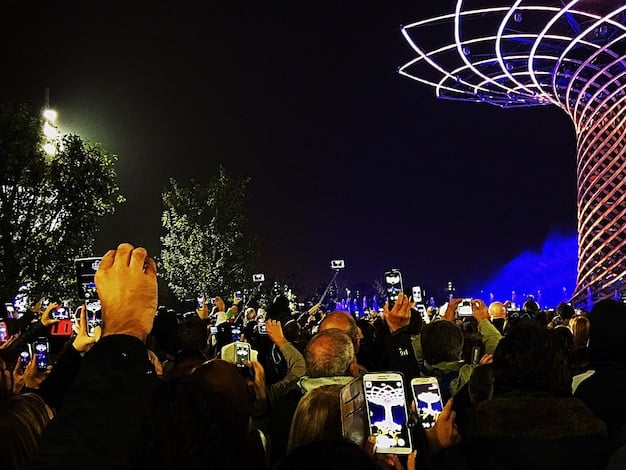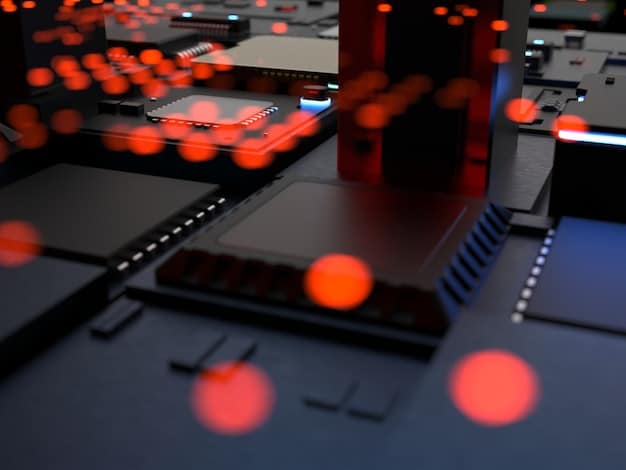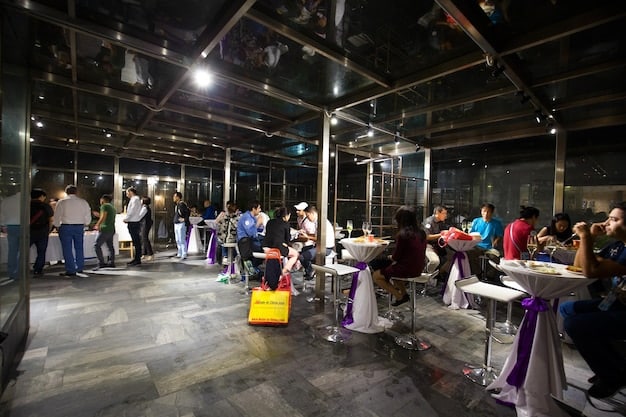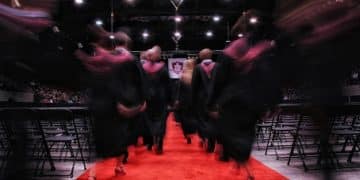The Future of Live Music: How US Concert Venues Adapt

The future of live music in the US is being shaped by concert venues adapting to changing tastes through enhanced experiences, technological innovation, and diverse offerings to attract a broader audience.
The live music scene in the United States is undergoing a significant transformation. The question is, how are venues adapting? The answer lies in understanding the evolving preferences of concert-goers and embracing innovation. Let’s explore the future of live music and how these spaces are changing the game.
The Evolution of Live Music Venues in the US
Live music venues in the United States have a rich history, evolving from simple stages in local bars to elaborate arenas and theaters. Today, these venues are not just places to see a show, but destinations that offer comprehensive entertainment experiences. Understanding this evolution is key to grasping the future of live music.
The shift towards immersive experiences and personalized entertainment is driving significant changes in how venues operate and cater to their audiences. As technology advances and tastes evolve, these spaces are adapting to remain relevant and appealing.
Historical Context of US Concert Venues
From the early days of jazz clubs and vaudeville theaters to the rise of rock and roll arenas, US concert venues have constantly adapted to reflect the changing musical landscape. The development of larger venues like Madison Square Garden alongside smaller, intimate clubs like The Roxy showcases the diverse range of experiences available to music lovers.
- Early Venues: Focused on acoustic performances and local talent.
- Mid-Century Arenas: Designed for large-scale touring acts and amplified sound.
- Modern Amphitheaters: Offer outdoor concert experiences during warmer months.
- Contemporary Clubs: Prioritize intimate settings and emerging artists.
Changing Audience Expectations
Modern concert-goers expect more than just great music. They seek memorable experiences that engage all their senses. This includes enhanced sound quality, visual spectacle, comfortable amenities, and personalized interactions. Venues are responding by investing in cutting-edge technologies and creating more engaging environments.

The demand for unique and shareable moments is also driving changes. Social media has amplified the importance of creating visually stunning experiences that attendees can capture and share. Venues are incorporating interactive elements and photo opportunities to cater to this trend.
In conclusion, the evolution of live music venues in the US is a story of continuous adaptation. By understanding historical trends and changing audience expectations, venues are positioning themselves to thrive in an increasingly competitive entertainment landscape.
Technological Innovations Transforming Concert Venues
Technology is playing a pivotal role in shaping the future of live music venues. From advanced sound systems to innovative lighting designs and interactive installations, technological advancements are enhancing every aspect of the concert experience. This transformation allows venues to offer more immersive and personalized events.
Embracing these innovations is not just about improving the quality of the show; it’s about creating entirely new ways for audiences to engage with music and artists. Let’s explore some of the key technological trends driving this change.
Advancements in Sound and Lighting
State-of-the-art sound systems and lighting designs are at the forefront of venue improvements. These technologies ensure that every seat in the house offers an optimal audio and visual experience. Venues are investing in sophisticated equipment to deliver crystal-clear sound and visually stunning light shows.
The use of advanced acoustics helps to minimize distortion and maximize clarity. Similarly, dynamic lighting systems can create dramatic effects, synchronizing with the music to enhance the emotional impact of the performance.
Interactive and Immersive Experiences
Interactive technologies are enabling venues to create more immersive experiences for concert-goers. This includes the use of virtual reality (VR), augmented reality (AR), and interactive projections that respond to audience movements and gestures. These technologies break down the barrier between the performer and the audience, creating a more engaging and participatory environment.
- Virtual Reality (VR): Allows attendees to experience concerts from different perspectives.
- Augmented Reality (AR): Overlays digital content onto the real-world environment.
- Interactive Projections: Create dynamic visual displays that respond to audience interaction.
- Digital Ticketing and Entry: Streamlines the entry process and reduces wait times.
Data Analytics and Personalization
Data analytics is another key area where technology is making an impact. By collecting and analyzing data on audience behavior and preferences, venues can personalize the concert experience. This includes tailoring marketing messages, offering targeted promotions, and customizing the layout and amenities of the venue.
Personalization can also extend to the performance itself, with artists using data to adapt their setlists and stage presence to better connect with the audience. This data-driven approach helps venues create experiences that are both enjoyable and relevant for their attendees.
In conclusion, technological innovations are fundamentally transforming concert venues, enhancing the quality of performances, and creating new opportunities for audience engagement and personalization. As technology continues to evolve, venues that embrace these advancements will be best positioned to attract and retain audiences.
Diversifying the Live Music Experience
To remain competitive, US concert venues are increasingly focused on diversifying the live music experience. This involves catering to a wider range of musical genres, incorporating non-musical elements, and creating multi-purpose spaces that can host a variety of events. By expanding their offerings, venues can attract more diverse audiences and maximize their revenue streams.
This diversification strategy is particularly important in a rapidly changing entertainment landscape where consumers have more choices than ever before. Venues that can offer unique and varied experiences are more likely to stand out and thrive.

Catering to Multiple Genres
Many venues are now designed to accommodate a variety of musical genres, from rock and pop to hip-hop, electronic music, and classical performances. This often involves investing in versatile sound and lighting systems that can be easily adapted to different styles of music. In effect, venues are looking to be more things to more people, by increasing their musical breadth to boost revenue.
Some venues also curate special events that showcase emerging artists and niche genres, helping to build a loyal fan base and attract new audiences. In doing so, they are aiming to be on the “cutting-edge” of music trends.
Incorporating Non-Musical Elements
Integrating non-musical elements such as art installations, food and beverage offerings, and interactive games can enhance the overall concert experience. These additions provide attendees with more opportunities to engage and socialize, turning the venue into a destination that offers more than just live music.
- Art Installations: Visual displays that enhance the atmosphere and provide photo opportunities.
- Food and Beverage Offerings: Gourmet food trucks and craft beer stations to cater to diverse tastes.
- Interactive Games: Fun activities and entertainment options to engage attendees before and after the show.
- VIP Experiences: Exclusive access to lounges, backstage tours, and meet-and-greets with artists.
Creating Multi-Purpose Spaces
Multi-purpose spaces are designed to host a wide range of events, including concerts, corporate meetings, private parties, and community gatherings. This flexibility allows venues to maximize their utilization and generate revenue throughout the year. By investing in adaptable infrastructure, venues can quickly transform their spaces to accommodate different types of events.
For example, a venue might host a rock concert on Friday night, a wedding reception on Saturday, and a business conference on Monday. This versatility helps to ensure that the venue remains busy and profitable, regardless of the fluctuating demands of the entertainment market.
In conclusion, diversifying the live music experience is essential for US concert venues to thrive in a competitive market. By catering to multiple genres, incorporating non-musical elements, and creating multi-purpose spaces, venues can attract diverse audiences and maximize their revenue potential.
The Role of Smaller, Intimate Venues
While large arenas and amphitheaters dominate the live music landscape, smaller, intimate venues play a crucial role in nurturing emerging talent and providing unique experiences for music lovers. These venues often offer a more personal connection between artists and audiences, fostering a sense of community and creativity. Understanding the value of these venues is key to appreciating the overall health of the live music ecosystem.
These spaces serve as incubators for up-and-coming bands, allowing musicians to hone their skills and build their fan base in a supportive environment. They also provide a platform for established artists to experiment with new material and connect with their fans on a more intimate level.
Supporting Emerging Artists
Smaller venues are essential for supporting emerging artists who might not have the opportunity to perform in larger arenas. These venues provide a platform for musicians to showcase their talent, build a following, and gain valuable experience in performing live. By providing a launching pad for new talent, these venues help to ensure the continued vibrancy and diversity of the music industry.
Many successful artists have honed their craft in small venues before moving on to larger stages. These venues often offer a more welcoming and nurturing environment for emerging artists, allowing them to take risks and develop their unique sound.
Creating Unique Audience Experiences
Intimate venues offer a unique and personal concert experience that is difficult to replicate in larger arenas. The close proximity between the artist and the audience creates a sense of connection and intimacy, allowing for more spontaneous interactions and improvisational performances. The experience for both the music-lover and performer is also elevated.
- Close Proximity: Creates a sense of connection between artist and audience.
- Spontaneous Interactions: Allows for more improvisational performances.
- Community Atmosphere: Fosters a sense of belonging among attendees.
- Unique Settings: Often located in historic buildings or unconventional spaces.
Fostering a Sense of Community
Smaller venues often become gathering places for like-minded individuals who share a passion for music and community. These venues foster a sense of belonging and camaraderie, providing a space for people to connect, share ideas, and celebrate their shared interests. With this fostering of community alongside the music, it is easy to see why these locations would attract music-lovers.
The intimate atmosphere of these venues encourages interaction and dialogue, creating a more engaging and participatory experience for everyone involved. This sense of community is a valuable asset that helps to sustain the venue and attract loyal patrons.
In conclusion, smaller, intimate venues play a vital role in the live music ecosystem by supporting emerging artists, creating unique audience experiences, and fostering a sense of community. These venues provide a valuable alternative to larger arenas, contributing to the overall diversity and vibrancy of the music scene.
Enhancing the Fan Experience Through Amenities and Services
US concert venues are increasingly focused on enhancing the overall fan experience by offering a range of amenities and services that go beyond just the music. This includes comfortable seating, high-quality food and beverage options, clean and accessible restrooms, and efficient customer service. By prioritizing the comfort and convenience of their patrons, venues can create a more enjoyable and memorable experience that keeps fans coming back.
These enhancements are particularly important in a competitive entertainment market where consumers have high expectations for service and quality. Venues that can deliver a seamless and enjoyable experience are more likely to stand out and attract loyal customers.
Comfortable Seating and Layout
Comfortable seating and a well-designed layout are essential for creating a positive concert experience. Venues are investing in ergonomic seating options that provide adequate support and space for attendees. A well-designed layout ensures that everyone has a clear view of the stage and easy access to amenities.
Some venues also offer premium seating options, such as VIP boxes and reserved seating areas, that provide enhanced comfort and service. These premium options cater to fans who are willing to pay more for a higher-quality experience.
High-Quality Food and Beverage Options
The availability of high-quality food and beverage options is another key factor in enhancing the fan experience. Venues are partnering with local vendors and gourmet chefs to offer a diverse range of culinary choices, from traditional concert fare to specialty dishes and craft beverages. There is a demand for more culinary variety at concert venues.
- Local Partnerships: Collaborating with local restaurants and food trucks to offer unique culinary experiences.
- Gourmet Options: Providing high-quality food choices that go beyond traditional concert fare.
- Craft Beverages: Offering a diverse selection of craft beers, wines, and cocktails.
- Dietary Accommodations: Catering to fans with dietary restrictions and preferences.
Efficient Customer Service
Efficient customer service is essential for ensuring a smooth and enjoyable concert experience. Venues are investing in training their staff to provide friendly, helpful, and responsive service to all attendees. This includes providing clear signage, easy access to information, and quick resolution of any issues or complaints.
Online ticketing systems and mobile apps can also streamline the customer service process, allowing fans to purchase tickets, access event information, and provide feedback with ease. These digital tools can significantly enhance the overall fan experience.
In conclusion, enhancing the fan experience through amenities and services is a key priority for US concert venues. By investing in comfortable seating, high-quality food and beverage options, and efficient customer service, venues can create a more enjoyable and memorable experience that keeps fans coming back.
Sustainability Initiatives in Music Venues
As environmental awareness grows, US concert venues are increasingly adopting sustainability initiatives to reduce their environmental impact and promote responsible practices. This includes implementing energy-efficient technologies, reducing waste, conserving water, and supporting local communities. By embracing sustainability, venues can not only reduce their carbon footprint but also attract environmentally conscious patrons and enhance their brand image. It helps sustain the venue and improve public perception.
The implementation of these initiatives reflects a broader trend towards corporate social responsibility in the entertainment industry. Venues that prioritize sustainability are positioning themselves as leaders in their field, demonstrating a commitment to environmental stewardship and social responsibility.
Energy Efficiency and Renewable Energy
Implementing energy-efficient technologies and utilizing renewable energy sources are key components of sustainability initiatives in music venues. This includes installing LED lighting, upgrading HVAC systems, and utilizing solar panels or wind turbines to generate electricity. These measures not only reduce energy consumption but also lower operating costs for the venue.
Some venues also participate in energy conservation programs and partner with local utility companies to further reduce their environmental impact. These efforts demonstrate a commitment to responsible energy management.
Waste Reduction and Recycling Programs
Reducing waste and implementing comprehensive recycling programs are essential for minimizing the environmental impact of concert venues. This includes providing recycling bins throughout the venue, composting food waste, and reducing the use of single-use plastics. These initiatives help to divert waste from landfills and conserve valuable resources.
- Recycling Bins: Providing clearly marked recycling bins throughout the venue.
- Composting Programs: Turning food waste into compost for use in landscaping.
- Reducing Single-Use Plastics: Encouraging the use of reusable cups, plates, and utensils.
- Partnerships with Waste Management Companies: Working with local companies to optimize waste reduction efforts.
Water Conservation Measures
Conserving water is another important aspect of sustainability initiatives in music venues. This includes installing low-flow toilets and faucets, utilizing drought-resistant landscaping, and implementing water-efficient irrigation systems. These measures help to reduce water consumption and conserve this precious resource.
Some venues also collect rainwater for use in irrigation or other non-potable applications. These innovative approaches help to further reduce the venue’s reliance on municipal water supplies.
In conclusion, sustainability initiatives are becoming increasingly important in US concert venues. By implementing energy-efficient technologies, reducing waste, and conserving water, venues can minimize their environmental impact and promote responsible practices. These efforts not only benefit the environment but also enhance the venue’s image and attract environmentally conscious patrons.
| Key Aspect | Brief Description |
|---|---|
| 🎶 Enhanced Fan Experience | Venues focus on comfort and convenience through better seating and services. |
| 🌱 Sustainability Initiatives | Venues are adopting energy and water conservation methods. |
| 💡 Technological Innovations | Tech helps enhance the audience experience. |
| 🎤 Diversification | Venues look to add variety to programming. |
Frequently Asked Questions
▼
Smaller venues are focusing on unique experiences to create appeal. This can include themed nights and local musical collaborations.
▼
Advanced sound and lighting technologies are enhancing the overall atmosphere. These can take place in the form of immersive visuals and enhanced sound.
▼
Venues use data to personalize experiences. This includes customizing marketing messages by gathering consumer data in advance of the show.
▼
Efforts include energy conservation plus improved recycling programs. This could mean the implementation of solar panels and energy reduction efforts.
▼
Providing clear information and accessible avenues help retain customers. By being attentive, users are more likely to stick around as concert-goers.
Conclusion
In conclusion, US concert venues are evolving to meet new needs. As tastes change, venues are enhancing the experience via technology, unique shows and customer service.





